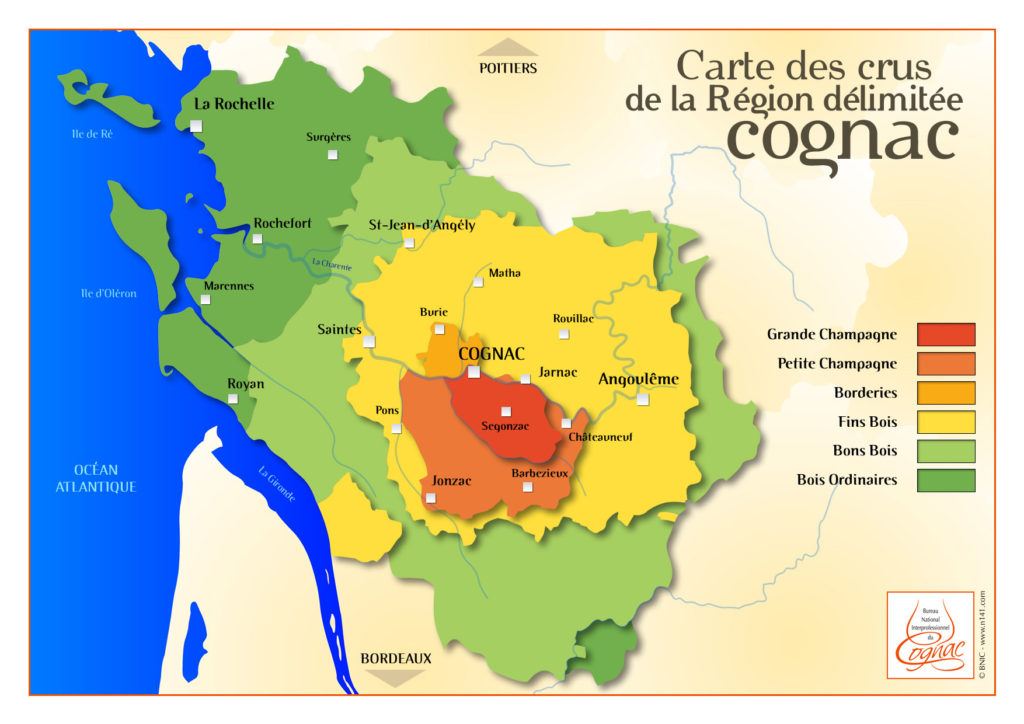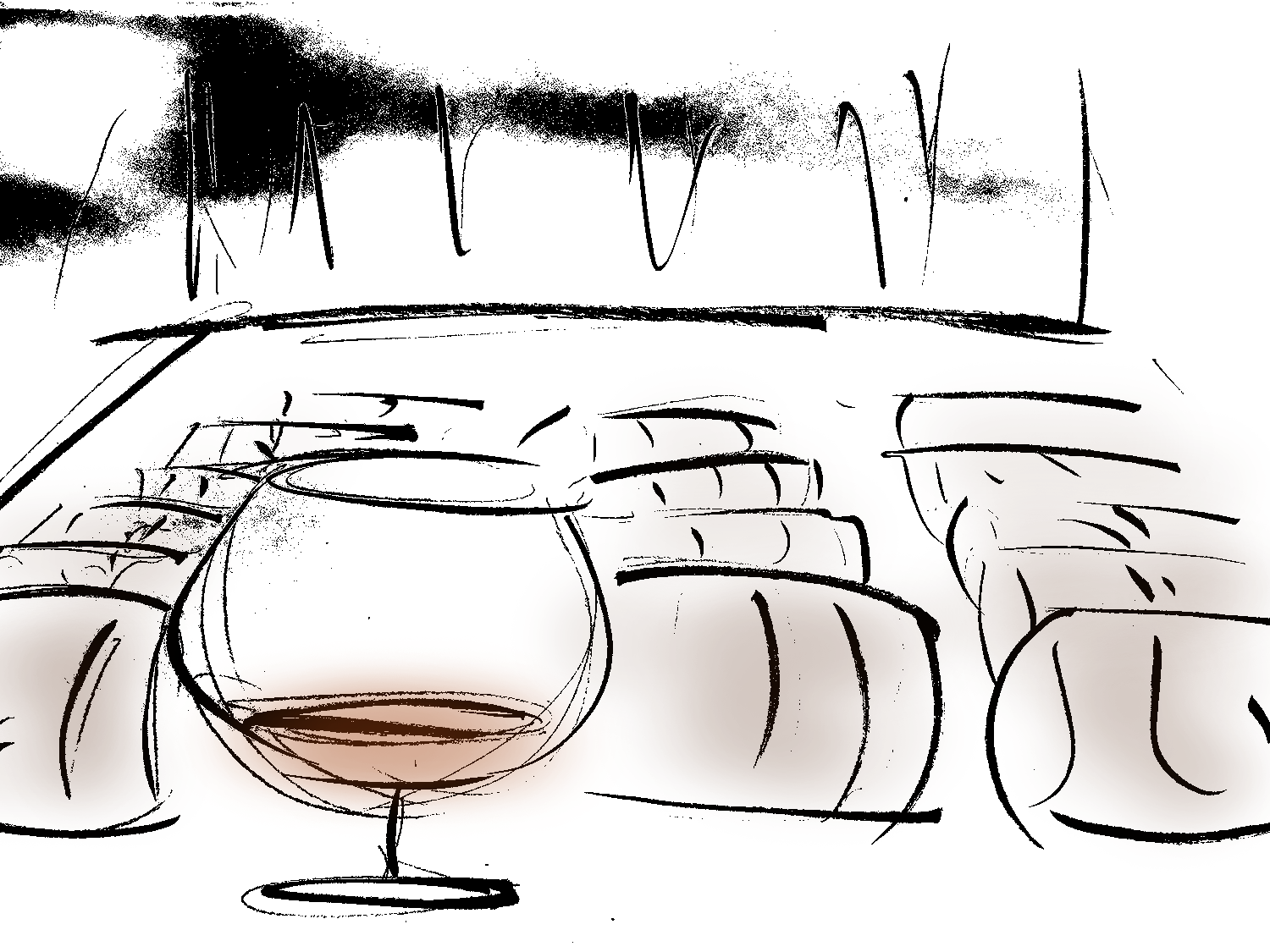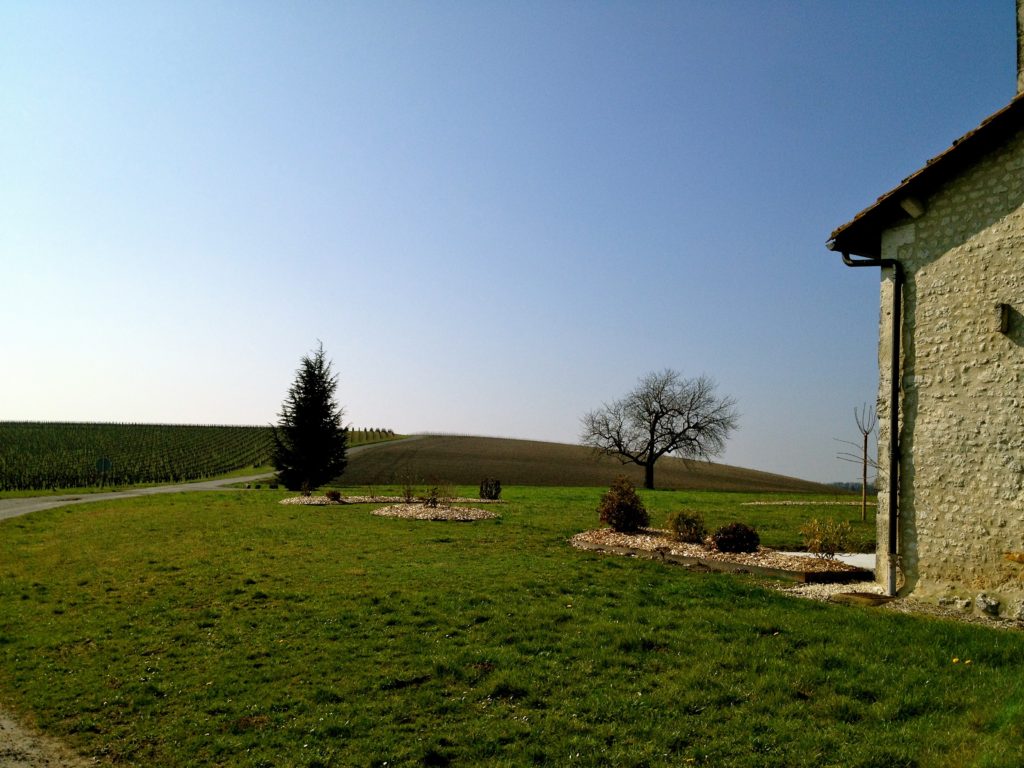The city of Cognac lies in the département Charente, 120 kilometres north of Bordeaux, which itself lies 120 kilometres north of the region of Armagnac.
History
- 13th century: The region around the river Charente is a grape region. Wine is traded by sea within Europe, inter alia also with the Netherlands.
- 17th century: To make the wine non-perishable for the long journey by sea, the Dutch import the still to the region. The wine is distilled two times and transported as eau-de-vie in wooden barrels. This was originally also the base for the Dutch jenever before moutwijn was used.
- 1715: The first cognac house Martell is founded, others follow. It is to be noted that most founders are not from the region Cognac themselves (Courvoisier is from Paris, Hennessy Irish…).
- 1875: The phylloxera (vine fretter) attacks the Charente and reduces the area of the vineyards to 40 000 hectares.
Growing Areas
- The region Cognac measures 75 000 hectares and is divided in 6 growing areas (crus). Had Caesar been more ahead of his time, he would have said: Cognac est omnia divisus in partes sex.
- The eaux-de-vie mature at different speeds depending on the area of origin. Those from the bois ordinaires mature quickest, those from the grande champagne slowest. This allows the latter to develop a high degree of complexity in the barrel.
- Grande & Petite Champagne: calcareous soil, eau-de-vie is fine, light with a floral bouquet
- Borderies: flint; eau-de-vie has notes of violet and iris
- Fin & Bon Bois: argillaceous soil; eau-de-vie juicy, round
- Bois Ordinaires: sandy soil; eau-de-vie has maritime notes

Grapes
- Cognac is produced from white grapes, amongst the most common are ugni blanc (also known as trebbiano), folle blanche and colombard.
- The vintage occurs in September and October; the grapes are pressed pneumatically (to prevent the pips from being crushed) and only once immediately after vintage. Then they are fermented.
- The resulting wine has between 7 and 9 % abv. and is acidic, which helps natural conservation.
- Note that practically all cognac houses buy most of the grapes from independent farmers, which are rewarded based on the quality of their produce.
Destillation

- Has to occur until the 31st of March of the year following the harvest.
- The wine may be filtered before distilling, or be distilled together with the yeast. This decision has a major impact on the flavour. Rémy Martin, for example, distills with the lees, while Hennessy filters the wine.
- Has to be performed in coppery alambic charentais, which may only be charged with up to 25 hectolitres per iteration.
- Has to be two-fold:
- First destillation produces about 800 litres cloudy brouillis with 28 to 32 % abv.
- Second destillation, for which primarily the middle run (coeur) used (and sometimes the toxic but flavourful tête) is used, produces 900 litres of the colourless bonne chauffe or eau-de-vie with up to 72 % abv. (In contrast to whisky, for example, which can be distilled to up to 95 % abv.)
Barrel & Aging

- Barrels are made by hand from Limousin or Tronçais oak wood without nails and adhesives.
- The barrels are charred in order to caramelise the wood, which gives more colour and flavour to the product.
- There are three stages in ageing:
- extraction: Takes place in new barrels and takes two years. The colourless eau-de-vie acquires a light golden colour and some vanilla.
- hydrolysis: the eau-de-vie is moved to a used cognac barrel, where it gains more colour and flavour.
- oxidation: this final stage helps to mellow out product and deepen the flavours.
- About 1.5 % abv. volatise per year (parte des anges)
- The amount of vaporisation depends on the surface area of the spirit in the barrel. For this reason, the master taster decides which barrels are stored vertically or horizontally.
- To compensate for the parte des anges, a sacrifice barrel is used, which contains eaux-de-vie from the same year, water and oak chips. The contents of this barrel is used to fill up the other barrels.
- On the ceilings of the cellars usually lives a fungus (Zasmidium cellare), which feeds on this alcohol vapour.
- If an eau-de-vie has aged enough in the opinion of the master taster, but for some reasons is not yet used for a product, it is stored in glass balloons (demijohns in a special part of the cellar (paradis).
Blending (marriage)
- eaux-de-vie of different regions and with different ages are blended by the master taster (maître de chai) to ensure a consistent flavour profile over the years.
- Reduction: Some water is added to most cognacs to bring them to 40 % abv. If the the cognac is reduced too fast, it develops a soapy taste. To prevent this, the reduction is performed already during ageing (8 % water per year).
- Additionally, up to 3 % sugar, caramel or oak chip can be added.
AOC
The AOC stands for Appellation d”Origine Contrôlée and regulates since 1936 by law which criteria have to be met so that a product is allowed to be called a cognac.
- Region: Grapes must be grown in the region Cognac.
- Grapes: Only certain grape varieties can be used.
- Vinification: No chaptalisation (adding sugar to grapes to increase alcohol gain), no sulfite (to make the wine non-perishable).
- Destillation: two-fold destillation to maximally 72 % abv. in coppery alambic charentais, which must only be charged with up to 25 hectolitres per iteration.
- Barrels: Has to be aged for at least two years in oak barrels.
- Distribution: At least 40 % abv., nothing added except for water, sugar, caramel and oak chips.
- Classification: Labels that are not described below, such as napoléon, are not regulated by the AOC, but defined by the houses themselves.
- fine only designates that the product obeys the AOC. Pretty redundant, because any cognac, by definition, does.
- fine champagne cognac is made of at least 50% grapes from the grande champagne; the remaining grapes have to be from the petite champagne.
- grande fine champagne cognac is made only of grapes from the grande champagne.
- VS (very special / superior): youngest eau-de-vie was aged for at least two years. Again, pretty redundant.
- VSOP (very special old pale): 4 years
- XO (extra old): 6 years, but due to the huge price spread in this category, this will be changed in 2016. After that, the youngest eau-de-vie has to be aged for 10 years to warrant this label.
Note how the labels VS, VSOP, XO are abbreviations for English descriptions. This is because cognac in its early days way primarily exported to the English speaking world.
Market
- In 2011, cognac generated over 2 billions € of turnover; over 160 million bottles have been sold. That”s more than five bottles per second.
- In 2012, there are about 16 000 people involved in the production of Cognac.
- Cognac is exported primarily to the United States, Singapore and China.
- Exports to Asia are mostly VSOP and XO cognacs.
- Exports to the US are mostly VS cognacs. There it enjoys great popularity amongst rap musicians and their fans, with a couple of them sporting their own brands (like Ludacris’ Conjure) or being involved in marketing campaigns.
Sources
- Lecture by Jürgen Deibel in August 2011
- Lecture by Uwe Voigt in September 2012
- Bureau Nation Interprofessionnel du Cognac

